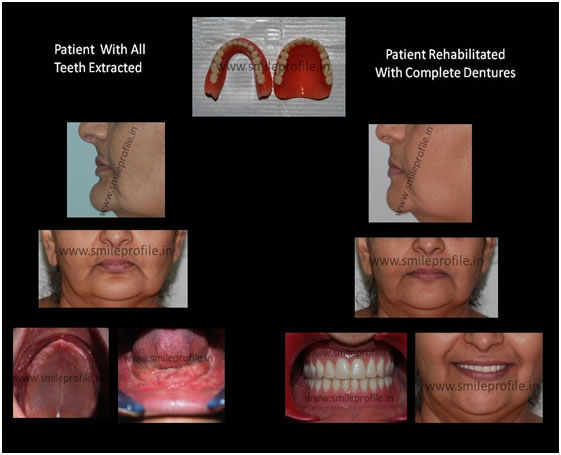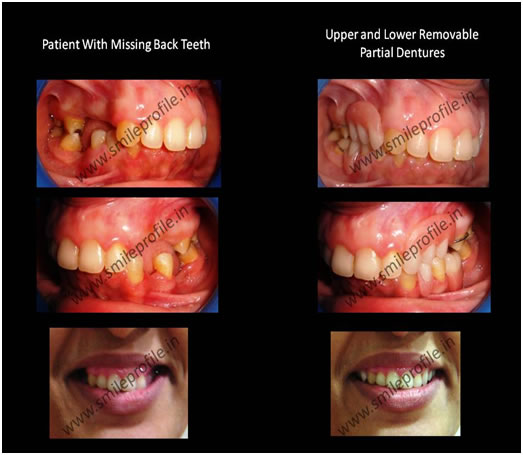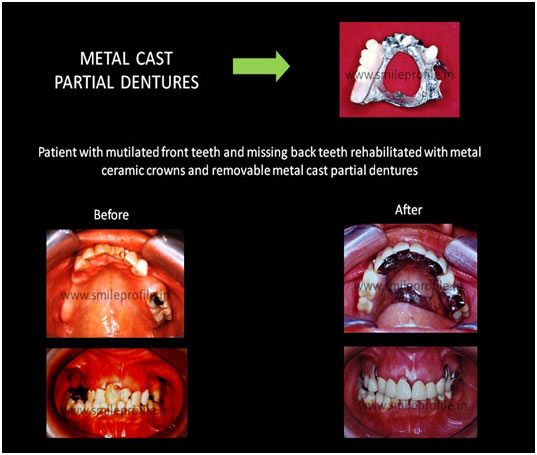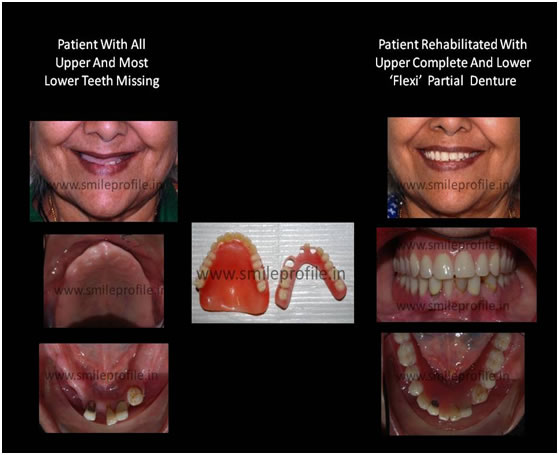A denture is a removable appliance (patients can put it on and remove it on their own)with either plastic or porcelain teeth, used to replace lost or missing natural teeth. If there are some natural teeth remaining in the jawbone, then the denture used to replace the missing teeth is called partial denture. If the denture replaces a complete arch of teeth, either upper or lower, it is called complete denture.
Complete Dentures
- Complete dentures refer to the replacement of an entire arch of teeth with a removable appliance bearing either acrylic or porcelain teeth.
- The advancements in materials and techniques have made patients experience with the denture quite satisfying. Not only one is able to chew food again, but the support provided by the denture to the lips and cheeks provides a dramatic improvement in the appearance of patients who have lost all their teeth.
- Though the dentures are not unbreakable, with the newer materials and artificial teeth sets available, they are quite strong. They are made up of high impact material and crosslinked teeth. This makes them resistant to breakage. However good care of dentures is needed to have a satisfying chewing experience.

Precautions and day to day care of the dentures
A denture is made of acrylic and therefore needs to be properly handled. It should not be dropped or left in direct sunlight for long periods of time. Proper care and good hygiene keep the mouth healthy. One should brush the dentures every day with a specific denture cleaning brush or any soft bristle toothbrush to remove food and plaque. A hard bristle brush or a wire brush should never be used on the denture, as the little scratches that can result will harbor bacteria and plaque. Denture cleaning powder or tablets are also available, which should be used for cleaning the dentures once in fifteen days by keeping one tablet or one tsp powder in a container containing dentures and water overnight. Next day the dentures can be cleaned in running fresh water. It is important to take out the dentures and properly clean the gums and tongue on a daily basis. The dentures should be removed from the mouth during sleeping hours. When dentures are not in the mouth, they should be in the water (never hot water) in a container to avoid them getting dirty or dried out.
Expectations from a new set of dentures
People who have lost all their teeth generally expect that once they receive their new set of dentures, they can start eating everything the way they used to when they had healthy natural teeth. However, it is important to understand that there is a ‘learning curve’ or a period of ‘settling in’ before one can use dentures to chew efficiently. There is a significant difference between healthy teeth embedded in bone and removable dentures resting over jawbone. Patients need to start initially with soft food and then gradually go on to harder food as they get trained in using their new dentures. How efficiently one is able to use their denture to chew hard food depends on the condition of the supporting jawbone as well as the individual adaptability of the patient. If needed, there is also the option of using two or more implants to significantly increase the stability of removable complete dentures, which leads to highly enhanced patient experience. Other issues felt by new denture users include increased saliva flow, a feeling of fullness in the mouth, altered taste sensation as roof of palate is covered by acrylic plate, reduced strength of chewing compared to natural teeth and altered speech (which can be improved within a week by reading aloud for half an hour daily). Most of these issues get resolved in one or two weeks.
When should existing dentures be replaced ?
All dentures have their life. Even though the dentures were made well and a patient had a satisfying experience with their appearance and chewing of food after few years dentures need adjustments or replacements. As the human body ages, there is a change in bone dimension and soft tissue (gums). In some people, the change is slow while in others the change is rapid. A good set of complete denture needs to be evaluated every three years. Most patients can continue using their existing dentures with mild to moderate adjustments or alterations. A new set of dentures may be required when teeth in existing dentures are considerably worn out, there is difficulty in eating or if the existing dentures are loose and/or causing frequent ulcers in the mouth.
Removable Partial Dentures (Rpd)
A Removable Partial Denture replaces some but not all teeth in the upper or lower jaw. There are several types of removable partial dentures. All of them use artificial teeth as replacements for the missing natural teeth. The difference between them is the material used to support the denture teeth and retain the RPD in the mouth. The various types of removable partial dentures being provided to our patients include :
- Acrylic dentures: Also known as flippers, these are the most cost-effective replacement option for missing natural teeth. As they are made of acrylic, they are brittle and slightly prone to breakage. To add strength and reduce the chances of breakage, they have to be made relatively thick. So they require some time to get used to. Moreover, as they rest solely on gum tissue, they are less stable than other replacement options. Hence, they are less preferred in contemporary practice compared to other types of removable dentures discussed below. However, they are still useful options for the cost-conscious patient and as a temporary replacement option for patients who have other damaged natural teeth which may soon be lost.

- Metal Removable Partial Dentures: Removable partial dentures with cast metal frameworks are excellent along-term replacement options in many clinical situations. The metal frameworks are cast from an extremely strong alloy called chrome cobalt which makes it possible to make very thin(hence less noticeable to the tongue and comfortable to patients) dentures, which are much more resistant to breakage compared to acrylic dentures. As they take support from both natural teeth and gums and is cast to achieve an extremely accurate fit, they are highly stable, retentive and very comfortable to the patient. However, in certain situations, some of the metal parts may be visible slightly compromising esthetics.

- Flexi Denture: These newer removable partial dentures are somewhat flexible, extremely light and at the same time very strong. There are no visible metal parts and the material itself blends with the tissues in the mouth so well that it looks extremely natural. The natural teeth don’t have to be altered or grinded in any way to fit these dentures. Because of their flexibility, high strength, lightweight, high level of comfort and extremely good esthetics, they are very popular with patients in modern dental practice.

Care of Flexi Dentures
- Flexi dentures are very durable and are designed to give long-term performance under normal usage. The denture base material will resist fracture or breakage better than the artificial teeth that are embedded in it. Small accidents such as dropping the denture in the sink or on the floor usually do not damage the denture but may cause the teeth to fracture. So one needs to handle the denture with care.
- The flexi denture needs to be cleaned regularly. Loose particles can be removed with the use of a sonic denture cleaner or by placing the denture under running water and using a denture cleaning brush. Toothpaste and toothbrushes may scratch or dull the surface of the flexi denture. It is necessary to remove the denture from the mouth whenever natural teeth are brushed. The denture needs to be kept in room temperature water whenever not in use.
